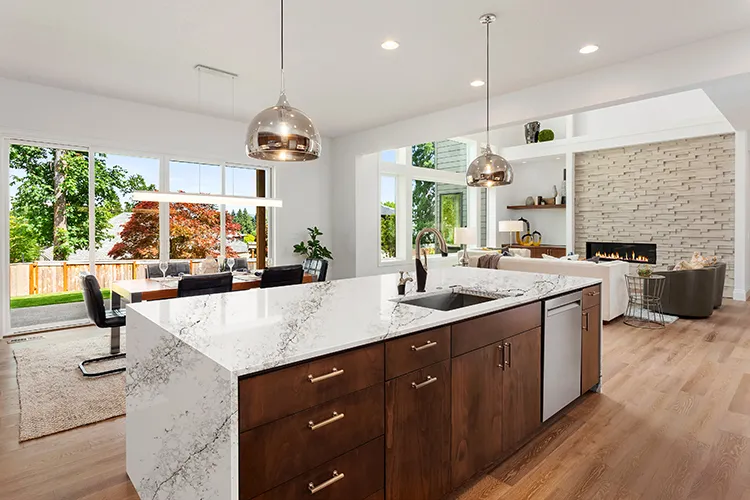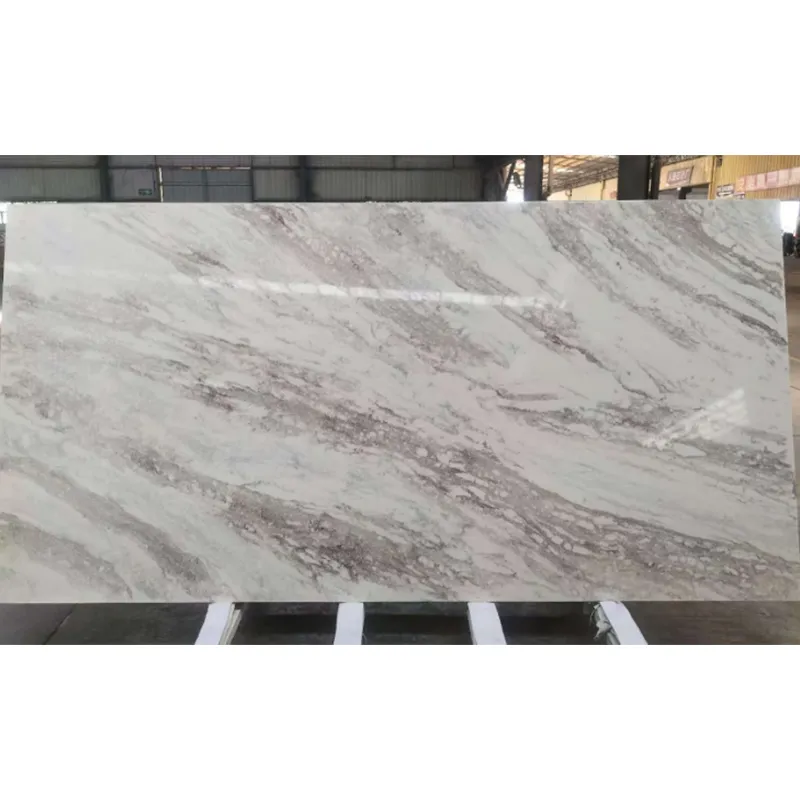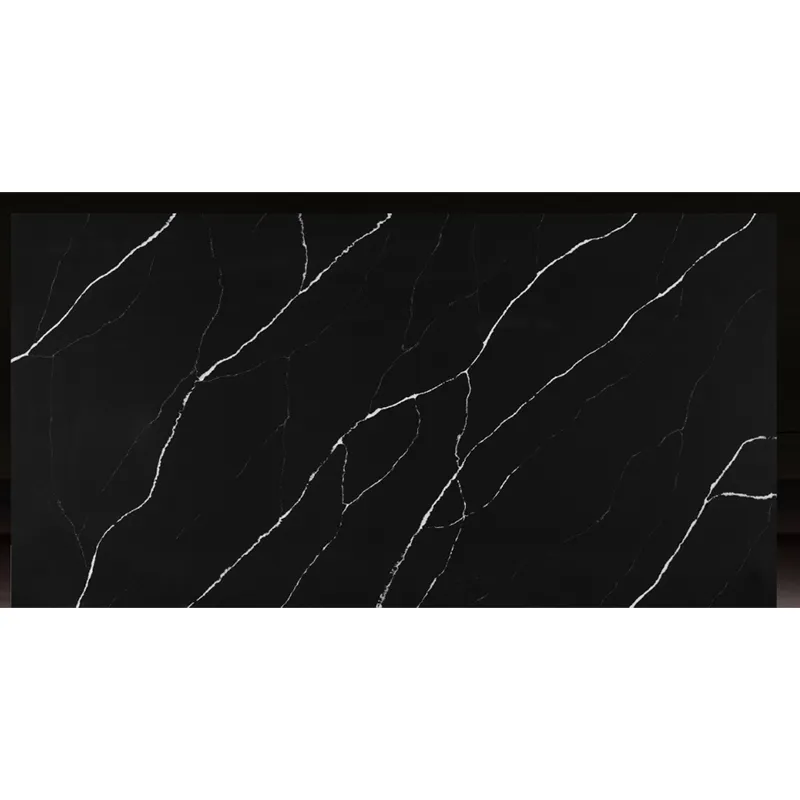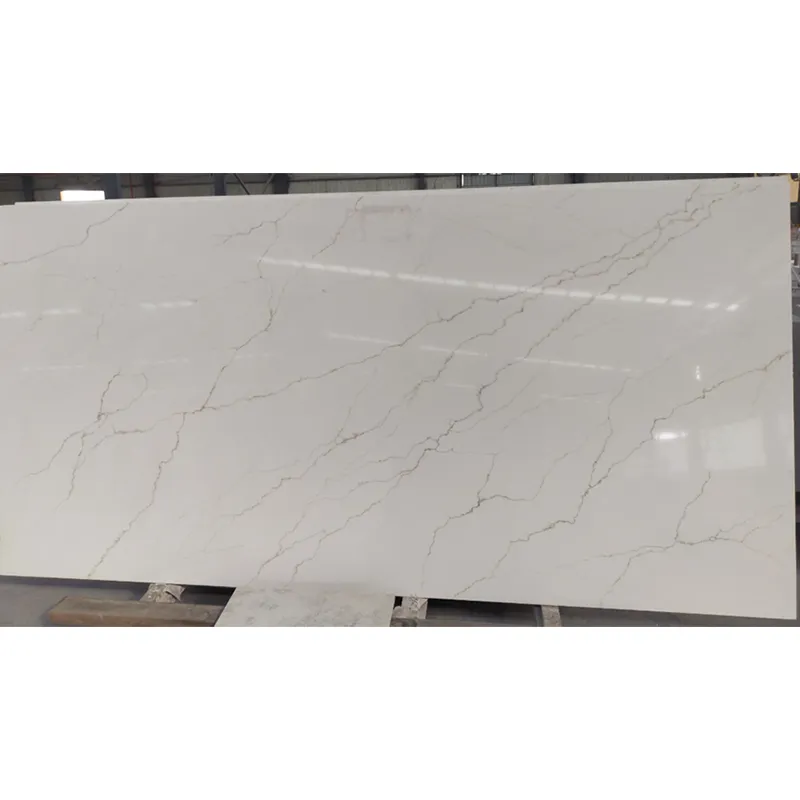In 2025, in modern kitchen design, choosing a countertop material that is both beautiful and practical is an important decision that every family has to face. Quartz countertops have become a popular choice in kitchen decoration due to their durability and diverse design options. Among the many quartz brands, Carrara and Calacatta Quartz Countertop are favored by consumers for their unique texture and noble appearance.
However, when faced with these two quartz countertops with such similar names, many people can't help but ask themselves: "What is the difference between them? Which one should I choose?" Although the two materials are similar in name, their respective characteristics, prices, maintenance requirements and durability are significantly different.
Today, we will answer these questions one by one, and analyze Calacatta Quartz Countertop and Carrara in detail from multiple aspects such as material, price, maintenance, durability, etc., to provide a comprehensive reference for your kitchen decoration.

What is Calacatta Quartz?
Calacatta Quartz is a high-end quartz stone known for its unique white background and thick gray or gold texture. It simulates the look of natural Calacatta marble, but is more durable and easy to maintain than natural stone. Unlike natural marble, Calacatta is highly resistant to staining, scratching, and erosion, making it an ideal choice for high-traffic areas such as kitchen countertops, backsplashes, and bathroom vanities. Calacatta Quartz not only has all the benefits of quartz, but also has unique aesthetic value, making it an ideal choice for luxury kitchen design.
Whether incorporated into modern, minimalist designs or traditional, ornate interiors, Calacatta stone gives people a sense of sophistication and grandeur. With its unparalleled blend of beauty and toughness, Calacatta remains a coveted choice for discerning homeowners, designers, and architects who seek lasting luxury in their spaces.
What colors are available for Calacatta Quartz Countertop?
With its diverse color and texture variations, Calacatta Quartz Countertop provides a wealth of options for kitchen design. The 3 most common colors of Calacatta Quartz Countertop: Classic White Calacatta, Gold Textured Calacatta, Light Gray Calacatta.
Classic White Calacatta- With its pure white background and thick grey veins, this color is the most classic and popular choice. It goes perfectly with all styles of kitchens, from modern simplicity to traditional classics, and can show a unique noble temperament.
Gold Textured Calacatta- Calacatta Quartz with gold veins adds gold veins on a white background, making the countertop more luxurious and gorgeous. Such a design is very suitable for high-end and luxury style kitchens, which can enhance the grade of the entire space.
Light Gray Calacatta- Calacatta Quartz with light gray adds delicate light gray veins on a white background, creating a low-key and elegant visual effect. This color is very suitable for modern and industrial style kitchen designs, making the space more stylish and textured.

How much does Calacatta Quartz Countertop cost?
You may wonder-is Calacatta artificial stone expensive?
The price of Calacatta stone color varies according to the thickness of the board and the type of quartz and the type of edge you choose. Generally speaking, the price of Calacatta Quartz Countertops ranges from $70 to $150 per square foot, and according to Home Advisor, the average cost you'll find in most quartz showrooms is about $75 per square foot excluding installation fees. The specific price depends on the brand, model, and installation fee.
Well-known brands of Calacatta Quartz Countertops are usually more expensive, but their quality and after-sales service are also more guaranteed. For example, brands such as Caesarstone, Silestone, and Cambria have a high degree of popularity and reputation in the market, and their prices are relatively high. High-quality Calacatta Quartz usually has higher purity and better manufacturing process, which can provide longer life and better appearance. Poor quality Calacatta Quartz may contain more impurities and defects, and the price is relatively low. Special textures and colors of Calacatta Quartz Countertops are usually more expensive because of the more complex manufacturing process. Classic white and gray textures are relatively cheap, while special colors such as gold and light gray are more expensive.
In short, we can only say that Calacatta Quartz is not expensive, considering its superior quality, beauty, and versatility.
Is Calacatta Quartz Countertop Good Quality?
One of the most durable countertop materials you will find, Calacatta stone is able to resist the scratches and wear of daily use, keeping it looking like new for a long time. Its non-porous structure makes it highly stain-resistant and antimicrobial, effectively resisting the invasion of bacteria and stains. Calacatta Quartz Countertop is not easily penetrated by stains, and can be kept clean by gently wiping with a damp cloth, reducing the worry of daily cleaning. Its heat resistance allows it to handle the high temperatures in the kitchen without discoloration or damage. Calacatta Quartz Countertop is available in a variety of colors and textures to meet the needs of different styles and personal preferences. Whether it is classic white, gray, or bolder gold and light gray textures, Calacatta Quartz will add nobility and elegance to the kitchen.
Which Calacatta Quartz is the most popular?
There are many beautiful white Calacatta stone colors, and it is difficult to choose the most popular color. However, we can say with certainty that among the many Calacatta Quartz Countertop models, the Classic White Calacatta Quartz Countertop is the most popular choice due to its pure, elegant appearance and wide applicability. With its white base and thick gray veins, this model mimics the natural beauty of natural Calacatta marble and blends in perfectly with kitchens of all styles.
In addition, the Gold Veined Calacatta Quartz Countertop is also very popular, especially in high-end and luxury kitchen designs. Its unique gold veins add a touch of luxury and opulence to the countertop, elevating the entire space.

What is Carrara Quartz?
Carrara Quartz is a high-end quartz stone designed to simulate the look of natural Carrara marble. Carrara marble is known for its white or blue-gray background and fine gray veins, while Carrara Quartz retains this classic beauty while offering the durability and easy maintenance benefits of quartz.
Made from a mixture of natural quartz crystals, resins, and pigments, Carrara Quartz is engineered to withstand the rigors of everyday use. Unlike natural marble, it is highly resistant to staining, scratching, and corrosion. Carrara Quartz is also heat-resistant, allowing hot pots and pans to be safely placed directly on its surface without worrying about damage.
Carrara Quartz Colors
Carrara Quartz is available in a variety of colors and textures to meet different design needs. Delicate, breathable, and stunning in appearance, Cashmere Carrara Quartz can provide any kitchen with a special sense of indulgence and high-end sophistication. 3 common colors of Carrara Quartz: Classic White Carrara, Blue Gray Carrara, Light Gray Carrara.
Classic White Carrara - With a white background and delicate gray texture, Classic White Carrara Quartz is the most classic and popular choice. It can perfectly match a variety of kitchen styles, from modern simplicity to traditional classics, and can show a unique noble temperament.
Blue Gray Carrara - Blue Gray Carrara Quartz adds a light blue-gray tone to the white background, making the countertop more unique and layered. This color is very suitable for modern and industrial style kitchen designs, making the space more stylish and rich in texture.
Light Gray Carrara - Light Gray Carrara Quartz adds delicate light gray texture on a white background, creating a low-key and elegant visual effect. This color is very suitable for modern and minimalist style kitchen designs, making the space more stylish and rich in texture.
Carrara Quartz Cost
Typically, Calacatta quartz costs more than Carrara quartz. This is mainly because the texture design of Calacatta quartz is more complex and requires higher manufacturing costs. In addition, Calacatta quartz has a more luxurious appearance and relatively high market demand, all of which keep its price high. Generally speaking, the price of Carrara Quartz ranges from $60 to $130 per square foot. Slightly lower than Calacatta Quartz's $70 to $150.
Although Calacatta quartz is more expensive, its unique visual effect and high-end texture often make people feel that it is worth the money. Carrara quartz, with its more moderate price and classic appearance, has become the first choice for families who pursue cost-effectiveness.
Calacatta Quartz Kitchen Design
It’s easy to transform your kitchen with Calacatta stone countertops. Known for its stunning appearance and versatility, Calacatta kitchen design offers a luxurious aesthetic that complements a variety of styles and materials. Calacatta Quartz is perfect as a countertop for kitchen islands and bars. Its spacious surface is not only suitable for placing dishes and food, but also serves as a centerpiece for family and friends to gather and provide a comfortable environment for communication. As a cooking work surface, Calacatta Quartz provides a flat, smooth surface for easy cutting and handling of ingredients. Its scratch and stain resistance allows it to cope with various cooking needs and maintain its new-like appearance for a long time. Calacatta Quartz Countertop can also be used as a wall and backsplash material, adding a sense of nobility and elegance to the kitchen. Its unique texture and color can be perfectly matched with various cabinets and floors, creating a unified and harmonious visual effect.
When it comes to kitchen cabinets, Calacatta complements a variety of finishes and colors. White cabinets create a seamless and cohesive look, allowing the intricate texture of quartz stone to take center stage. Darker cabinets, such as deep charcoal or espresso, create a striking contrast, adding depth and dimension to a space.
Carrara Quartz Kitchen Design
Like calacatta quartz, Carrara Quartz is equally suitable as a countertop for kitchen islands, bar counters and cooking worktops. Its subtle gray veins and pure white background add a soft and warm touch to a space, making it comfortable and enjoyable for family members and friends to gather. If you want a range of white and gray tones, mixed with subtle textures for a unique look in natural variations, this extraordinary kitchen countertop is the answer.
Carrara Quartz is perfect for traditional and modern kitchens, adding a touch of sophisticated luxury to any space. In traditional kitchens, Carrara Quartz pairs perfectly with intricate wooden cabinetry, ornate hardware and vintage-style fixtures to create a timeless appeal. In modern kitchens, it enhances minimalist designs with its clean lines and subtle textures, adding depth and sophistication to a space.

Calacatta Quartz Countertop Vs. Carrara
What is the difference between Calacatta and Carrara?
First, let's start with the appearance and origin to understand the main differences between Calacatta and Carrara quartz. Calacatta and Carrara are originally two natural marbles from Italy, which are famous all over the world for their unique veins and elegant appearance. Calacatta marble is usually produced in the Italian Alps, while Carrara marble is named after the Carrara region in Italy. The unique veins and colors of these two marbles have become an important source of inspiration for modern quartz countertop designs.
Calacatta Quartz features thick gray or gold veins and a pure white background, which is suitable for creating a luxurious and noble atmosphere. Carrara Quartz features fine gray veins and a white or blue-gray background, which is suitable for creating an elegant and soft atmosphere. Although both are mainly white bases, their veins are significantly different. Calacatta quartz usually has bold, heavy gray or gold veins, which contrasts sharply with its clean white background. This strong visual effect makes Calacatta quartz countertops a focal point in the kitchen. In contrast, Carrara Quartz exhibits a softer, more delicate gray texture that contrasts gently with the white background, giving the overall effect a more low-key effect. This design makes Carrara Quartz countertops more suitable for creating a serene, elegant kitchen atmosphere.
Price-wise, Calacatta Quartz is generally slightly more expensive than Carrara Quartz, mainly due to its intricate texture and high-end appearance. However, the specific price is subject to brand, model, and installation costs.
How do Calacatta Quartz Countertops and Carrara differ in terms of maintenance and care?
In daily use, there is no difference in the cleaning and care of Calacatta Quartz Countertops and Carrara. Due to the non-porous nature of quartz materials, neither of them easily absorbs liquids and stains, which makes their surfaces very easy to clean. Usually, you can keep your countertop clean by simply wiping it with mild soapy water and a soft cloth. If you cook frequently, multiple times a day, this may be your regular daily cleaning routine. If you don't cook often, a simple wipe with a damp cloth is sufficient for daily cleaning.
Although there is little difference in cleaning between the two, Calacatta Quartz Countertop may require a higher level of cleaning agents due to its more prominent texture and color. For example, using a cleaner with bleach may affect the color vividness of Calacatta quartz. Therefore, when choosing a cleaner, it is recommended to choose a neutral cleaner to protect its original color and luster.
Calacatta Quartz Countertop vs. Carrara, which one is more scratch-resistant or stain-resistant?
Calacatta and Carrara quartz usually have a Mohs hardness of 7, which means that they are both highly scratch-resistant in daily use. However, due to the more obvious texture of Calacatta quartz, scratches may be more visually prominent. But during use, Calacatta quartz may require more care to avoid visual damage.
Due to the non-porous nature of the quartz material itself, both Calacatta Quartz Countertop and Carrara show excellent stain resistance. Generally, common stains such as coffee, red wine, grease, etc. will not leave difficult-to-remove marks on their surfaces. However, Calacatta Quartz has a more contrasting color and texture, which may show stains more easily in some cases, so it is recommended to clean up spills in time.
Which is more durable, Calacatta Quartz Countertop or Carrara?
If your kitchen is used frequently and you want the countertop to maintain its good appearance after long-term use, Carrara Quartz may be a more practical choice. In some high-intensity use environments, such as home kitchens or catering industries, Carrara Quartz may be more suitable. On the contrary, if you pay more attention to the visual effect of the countertop and are willing to pay more attention to it, then Calacatta Quartz Countertop will be a worthy investment.

What is the most popular Calacatta Quartz?
Calacatta Gold is one of the most popular Calacatta Quartz Countertops, known for its golden texture and white base. This quartz material not only has a noble appearance, but also adds a touch of warm color to the kitchen, making it the material of choice for many high-end kitchens. Another popular Calacatta Quartz is Calacatta Classic, which is a combination of gray rough texture and classic white base. This design makes it look elegant and modern in kitchens of different styles, making it very popular.

